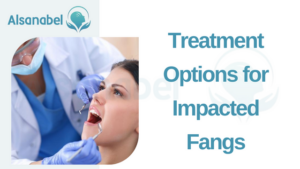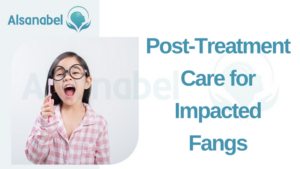Understanding Impacted Fangs
Impacted fangs, also known as impacted canines, occur when the canines, or fangs, fail to properly emerge and align with the rest of the teeth. This dental condition often occurs during the teenage years, when the permanent teeth are developing. Understanding impacted fangs can help individuals take necessary steps to address and treat this issue effectively.
It can lead to various dental problems if left untreated. The canines play a crucial role in the bite and alignment of the teeth, so when they do not come in properly, it can cause issues such as overcrowding and misalignment. In some cases, impacted fangs can even damage neighboring teeth or cause infection.
Causes and Risk Factors
There are several causes and risk factors that can contribute to impacted fangs. One of the common causes is inadequate space in the mouth. If the jaw is too small or there are other overcrowding issues, it can prevent the proper eruption of the canines.
Additionally, genetics can play a role in the development of impacted fangs. If a family member has had impacted canines, there is a higher likelihood that an individual may also experience this dental condition.
Other risk factors include early loss of baby teeth, abnormalities in tooth development, and certain oral habits such as thumb sucking or prolonged bottle feeding.
It is important to address impacted fangs promptly to prevent potential complications. Consulting with a dental professional can determine the best course of action, which may involve orthodontic treatment or even oral surgery to help the impacted fangs properly align with the other teeth. By understanding the causes and risk factors, individuals can take proactive steps to maintain their oral health and ensure proper alignment of their teeth.
Signs and Symptoms of Impacted Fangs

Potential signs
When it comes to impacted fangs, there are several potential signs that individuals should be aware of. While these signs may not always indicate the presence of it, they can serve as red flags and prompt individuals to seek dental evaluation. Some common potential signs include:
- Dental crowding: It can lead to overcrowding in the mouth, causing other teeth to shift or become misaligned.
- Tooth displacement: In some cases, it can cause neighboring teeth to be pushed out of position or even be affected by decay or infection.
- Gum swelling and pain: It can cause gum irritation, swelling, and tenderness around the affected area.
- Visible or palpable lump: A small, firm lump may be felt or seen in the gum tissue where the it is present.
- Delayed or abnormal tooth eruption: If a fang is significantly delayed in erupting or appears to be emerging at an unusual angle, it may be a sign of an impacted fang.
Common symptoms and complications
When impacted fangs are left untreated, they can lead to various dental problems and complications. Some common symptoms and complications include:
- Pain and discomfort: Impacted fangs can cause persistent pain and discomfort, especially when chewing or biting.
- Increased risk of tooth decay: The presence of impacted fangs can make oral hygiene maintenance challenging and increase the risk of tooth decay and gum disease.
- Increased risk of infection: Impacted fangs can create pockets in the gum tissue where bacteria can accumulate, leading to infection.
- Bite problems: When impacted fangs disrupt the proper alignment of the teeth, it can cause bite problems and affect the overall function of the mouth.
- Orthodontic complications: If left untreated, impacted fangs can complicate orthodontic treatment and may require additional intervention to achieve proper alignment.
It is essential for individuals to recognize these signs and symptoms of impacted fangs and seek professional dental evaluation and treatment promptly. Early intervention can help prevent further complications and ensure proper alignment of the teeth, leading to improved oral health and overall well-being.
Diagnosing Impacted Fangs
Methods for diagnosing Impacted Fangs
Identifying and diagnosing impacted fangs is crucial for prompt intervention and treatment. Dental professionals use various methods to determine if fangs are impacted. These methods include:
- Visual Examination: Dentists visually inspect the mouth and teeth to look for signs of impacted fangs. They check for crowding, displacement of neighboring teeth, gum swelling, and visible or palpable lumps.
- Physical Examination: Dentists perform a physical examination of the mouth, feeling for abnormalities and checking the movement and positioning of teeth.
- Dental X-rays: Dental X-rays play a significant role in diagnosing impacted fangs. They provide a clear view of the tooth’s position, orientation, and proximity to neighboring teeth and structures. X-rays can reveal whether a fang is impacted and its location within the jaw.
Importance of dental X-rays in diagnosis
Dental X-rays are invaluable tools in diagnosing impacted fangs. They provide detailed information that aids in treatment planning and decision-making. X-rays help dentists:
- Confirm the presence of impacted fangs: X-rays reveal the location and orientation of fangs that may be hidden beneath the gumline, allowing for an accurate diagnosis.
- Determine the severity and position: X-rays help determine the degree of impaction and the fang’s position in relation to neighboring teeth. This information is vital for planning the appropriate treatment approach.
- Identify potential complications: X-rays can identify any potential complications associated with impacted fangs, such as damage to neighboring teeth, cyst formation, or infection.
- Monitor growth and development: Dental X-rays enable dentists to track the growth and development of impacted fangs over time, allowing for timely intervention if necessary.
In conclusion, diagnosing impacted fangs involves a comprehensive examination that may include visual assessment, physical evaluation, and dental X-rays. These diagnostic methods enable dentists to accurately assess the presence, position, and potential complications of impacted fangs, leading to appropriate treatment planning and improved oral health outcomes.
Treatment Options for Impacted Fangs

Possible treatment approaches
When diagnosing impacted fangs, it is crucial to consider the appropriate treatment options. The choice of treatment depends on factors such as the severity of impaction, the position of the impacted fang, and the age and overall oral health of the patient. Here are some possible treatment approaches for impacted fangs:
- Watchful Waiting: In some cases, especially when the impacted fang is not causing any immediate problems, dentists may choose to monitor the situation closely. Regular dental check-ups and X-rays can determine if intervention is necessary in the future.
- Tooth Extraction: If the impacted fang is causing pain, crowding, or affecting the alignment of neighboring teeth, extraction may be necessary. This procedure involves removing the impacted tooth to alleviate discomfort and prevent further complications.
- Surgical Exposure and Orthodontic Alignment: In more complex cases, surgical exposure of the impacted fang and orthodontic treatment may be required. A dental surgeon will uncover the impacted fang and attach an orthodontic appliance to guide it into its proper position in the dental arch.
Surgical procedures and alternative treatments
Depending on the specific circumstances, dentists may recommend surgical procedures or alternative treatments for impacted fangs. Some common approaches include:
- Orthodontic Exposures: This surgical procedure involves exposing the impacted fang by making a small incision in the gum tissue. Once exposed, the orthodontist can attach an orthodontic device to guide the tooth’s movement.
- Orthodontic Traction: In cases where the impacted fang is positioned higher in the jawbone, orthodontic traction may be necessary. This procedure gradually pulls the impacted tooth into its correct position using wires and brackets.
- Temporary Anchorage Devices (TADs): TADs are mini-implants that provide temporary anchorage during orthodontic treatment. They can be used to facilitate the movement of impacted fangs and ensure proper alignment.
- Aligner Therapy: In some instances, clear aligners can be used to gradually move the impacted fang into alignment. This alternative treatment option is less invasive than traditional braces and may be suitable for certain cases.
It is important to consult with a dental professional to determine the most appropriate treatment option for impacted fangs. They will evaluate the individual’s specific condition and recommend the best course of action to ensure optimal oral health and
The Top Natural Antibiotics for Tooth Infections 2023
Preparing for Impacted Fangs Treatment
Steps to take before undergoing treatment
Before undergoing treatment for impacted fangs, it is important to take certain steps to ensure a smooth and successful procedure.
- Schedule a Consultation: The first step is to schedule a consultation with a dental professional who specializes in impacted fangs treatment. They will evaluate your specific case and recommend the most appropriate treatment approach.
- Gather Information: During the consultation, ask any questions you may have and gather all the necessary information about the treatment process. Understand the potential risks, benefits, and expected outcomes.
- Follow Pre-Treatment Instructions: Your dental professional may provide specific instructions to prepare for the treatment. This may include fasting before the procedure, avoiding certain medications, or arranging for transportation to and from the dental office.
- Arrange Support: Depending on the complexity of the treatment, you may need someone to accompany you to the appointment and provide assistance during the recovery period. Inform a trusted friend or family member about your treatment plans and ensure their availability.
Understanding the recovery process
The recovery process after impacted fangs treatment can vary depending on the specific procedure performed. It is important to have a clear understanding of what to expect during the recovery period.
- Post-Procedure Care: Your dental professional will provide detailed instructions on how to care for your oral hygiene after the treatment. This may include recommendations for pain management, dietary restrictions, and proper brushing and flossing techniques.
- Follow-up Appointments: It is crucial to attend all follow-up appointments recommended by your dental professional. These appointments allow them to monitor your progress, remove any stitches if necessary, and ensure proper healing.
- Manage Discomfort: It is normal to experience some discomfort, swelling, and bruising after the procedure. Follow the pain management techniques suggested by your dental professional, such as applying ice packs and taking prescribed medications.
- Practice Patience: The recovery process for impacted fangs treatment can take time. Be patient and allow your body to heal naturally. Avoid strenuous activities and follow all post-treatment instructions provided by your dental professional.
By taking these steps and understanding the recovery process, you can better prepare yourself for impacted fangs treatment and ensure a successful outcome for your oral health. Remember to consult with a dental professional for personalized advice and support throughout the treatment journey.
Post-Treatment Care for Impacted Fangs
After undergoing treatment for impacted fangs, it is crucial to follow proper post-treatment care to ensure a successful recovery and maintain your oral health. Here are essential care tips to consider:

Essential care tips after treatment
- Oral Hygiene: Proper oral hygiene is vital in preventing infections and promoting healing. Brush your teeth gently with a soft-bristled toothbrush and an antibacterial mouthwash to keep the treated area clean.
- Pain Management: It is normal to experience some discomfort and swelling after the treatment. Follow the pain management techniques recommended by your dental professional, such as using cold compresses and taking prescribed pain medications.
- Dietary Restrictions: Avoid hard and chewy foods that could potentially harm the treated area. Stick to soft foods, such as soups, yogurt, and mashed vegetables, until you have fully healed.
- Follow-up Appointments: Attend all follow-up appointments scheduled by your dental professional. These appointments are crucial to monitor your progress, remove any stitches if necessary, and ensure proper healing.
Potential long-term complications and preventive measures
While the majority of impacted fangs treatments are successful, there are potential long-term complications that may arise. These include:
- Relapse: In some cases, the impacted fangs can gradually shift back to their original position. To prevent relapse, wear any prescribed retainers or orthodontic devices as directed by your dental professional.
- Infections: If proper oral hygiene is not maintained, infections can develop around the treated area. Regularly visit your dentist for check-ups and cleanings to prevent infections and promote overall oral health.
- Damage to Adjacent Teeth: Impacted fangs can sometimes cause damage to neighboring teeth. Follow preventive measures such as wearing a mouthguard during physical activities to protect your teeth from trauma.
By following these essential care tips and being aware of potential long-term complications, you can ensure a successful outcome for your impacted fangs treatment. Always consult with your dental professional for personalized advice and support throughout your recovery journey.
Frequently Asked Questions
If you’re dealing with impacted fangs, you likely have some questions about the condition and its treatment. Here are answers to some commonly asked questions:
- What are impacted fangs?
Impacted fangs occur when the canine teeth fail to erupt or emerge properly from the gum line. They may remain trapped in the bone or soft tissue, causing discomfort and potential oral health issues.
- What causes impacted fangs?
The most common cause of impacted fangs is the lack of space in the dental arch to accommodate the canine teeth. Other factors, such as abnormal growth patterns or genetics, can also contribute to the condition.
- How are impacted fangs diagnosed?
Your dentist or orthodontist will carefully examine your teeth and take X-rays to determine the presence and severity of impacted fangs. They may also use additional imaging techniques to assess the position and orientation of the affected teeth.
- What are the treatment options for impacted fangs?
Treatment for impacted fangs typically involves a combination of orthodontic intervention and oral surgery. The orthodontist may use braces or aligners to create space for the impacted teeth, while the oral surgeon will perform a surgical procedure to expose and align the fangs.
Expert advice and recommendations
When dealing with impacted fangs, it’s crucial to seek professional guidance. Here are some expert recommendations and advice:
- Don’t ignore the problem: Impacted fangs can lead to various complications if left untreated, such as infections, damage to adjacent teeth, and misalignment of the bite. It’s important to address the issue as soon as possible.
- Consult with an orthodontist: An orthodontist specializes in diagnosing and treating dental alignment issues. They can assess your situation and recommend the best course of treatment.
- Follow the treatment plan: It’s essential to follow the recommendations and treatment plan outlined by your dental professionals. This may include regular check-ups, wearing retainers, and practicing good oral hygiene.
- Be patient: Correcting it can take time and requires patience. It’s important to trust the expertise of your dental team and understand that the process may involve multiple stages and adjustments.
By understanding the nature of impacted fangs, seeking professional advice, and following the recommended treatment plan, you can effectively address this dental issue and achieve a healthy, aligned smile.
